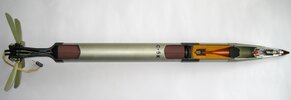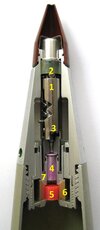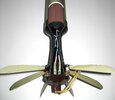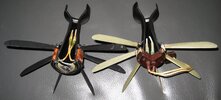microplastic
Well-Known Member
Cutaway model of a Russian 57mm S-5K HEAT rocket, introduced in 1960. The rocket is used against armored targets, the shape charge can penetrate up to 130mm of armor plate. The fuze is a V-5K Point-Detonating, spit-back fuze with a side impact element without self destruction.
The rocket motor is one powder stick in a steel tube with an elongated eight-fin exhaust nozzle at the rear. The used nozzle is the first version with a pin-type connector plug with wires that was replaced in the 1960s by a version with a pair of metal contact plates on a bakelit cap. The newer version makes it easier and faster to reload the launcher.
When the rocket is fired, the rocket motor's igniter receives an electrical pulse and ignites the motor igniter charge. The rocket motor burns for just 1.1 seconds and flies about 300 meters during this time. The wings fold out and bring the rocket to approx. 750 rpm.
On rocket launch, setback forces the striker sleeve (1) downward, releasing the three upper safety balls (2). When the setback ceases, the sleeve spring pushes the striker sleeve (1) forward to the underside of the striker's head, releasing the four lower safety balls (3). The fuze is armed. The sleeve has a zigzag path that slows its movement for 0,01 sec.–0.02 sec. That makes sure that the fuze is armed at a safe distance from the aircraft. On impact, the striker drives the firing pin into the primer detonator (4), initiating the spit-back booster (5). The flame of this booster travels through the flash channel of the copper cone to the lower detonator (K-1-T) at the base, exploding the main charge. On side impact, the brass ring (6) is thrown sideways, forcing the primer detonator housing (7) upward and pushing the primer (4) into the firing pin.
The internal parts of the rocket were missing, they are all 3D-printed (PLA – plastic).
Length of the rocket : 835mm
Diameter of the rocket : 57mm
Weight of the warhead : 1.26 kg
Weight of the rocket : 3.64 kg
Fuze of the warhead : V-5K/V-5K1
Range of the rocket : 3000m
Max. speed: 549 to 620 m/s
The rocket motor is one powder stick in a steel tube with an elongated eight-fin exhaust nozzle at the rear. The used nozzle is the first version with a pin-type connector plug with wires that was replaced in the 1960s by a version with a pair of metal contact plates on a bakelit cap. The newer version makes it easier and faster to reload the launcher.
When the rocket is fired, the rocket motor's igniter receives an electrical pulse and ignites the motor igniter charge. The rocket motor burns for just 1.1 seconds and flies about 300 meters during this time. The wings fold out and bring the rocket to approx. 750 rpm.
On rocket launch, setback forces the striker sleeve (1) downward, releasing the three upper safety balls (2). When the setback ceases, the sleeve spring pushes the striker sleeve (1) forward to the underside of the striker's head, releasing the four lower safety balls (3). The fuze is armed. The sleeve has a zigzag path that slows its movement for 0,01 sec.–0.02 sec. That makes sure that the fuze is armed at a safe distance from the aircraft. On impact, the striker drives the firing pin into the primer detonator (4), initiating the spit-back booster (5). The flame of this booster travels through the flash channel of the copper cone to the lower detonator (K-1-T) at the base, exploding the main charge. On side impact, the brass ring (6) is thrown sideways, forcing the primer detonator housing (7) upward and pushing the primer (4) into the firing pin.
The internal parts of the rocket were missing, they are all 3D-printed (PLA – plastic).
Length of the rocket : 835mm
Diameter of the rocket : 57mm
Weight of the warhead : 1.26 kg
Weight of the rocket : 3.64 kg
Fuze of the warhead : V-5K/V-5K1
Range of the rocket : 3000m
Max. speed: 549 to 620 m/s






